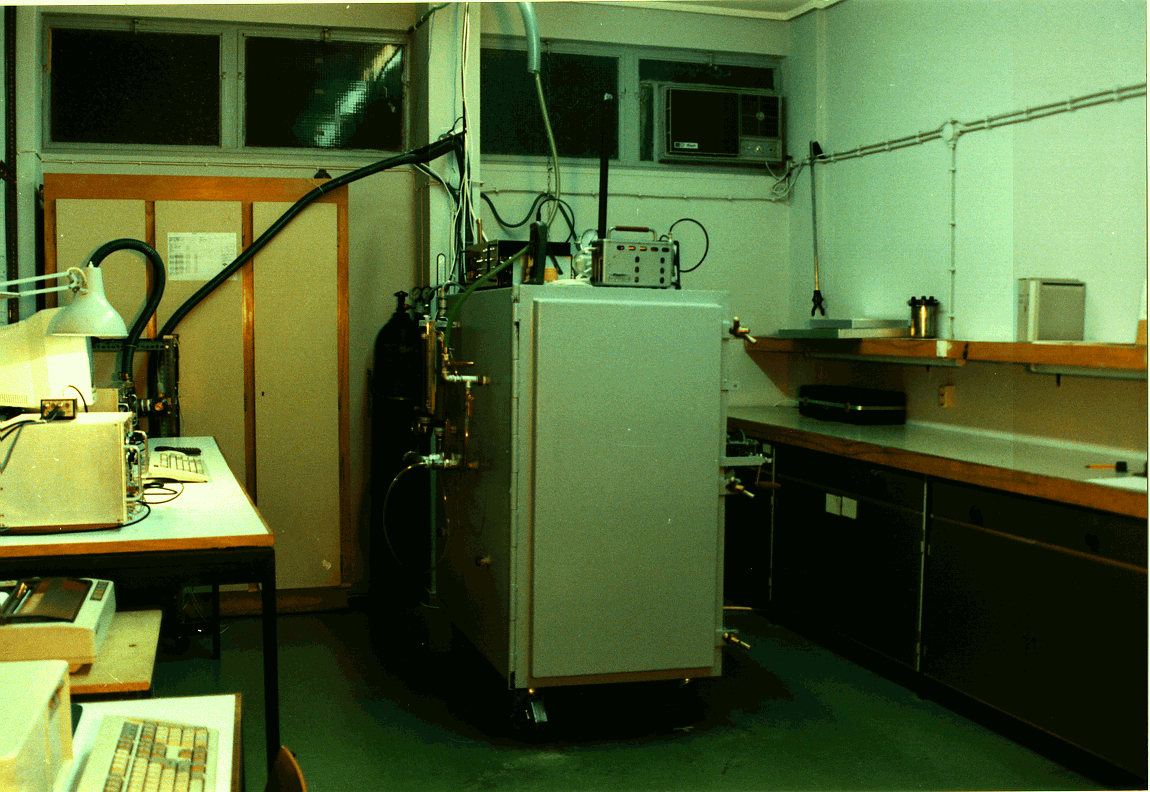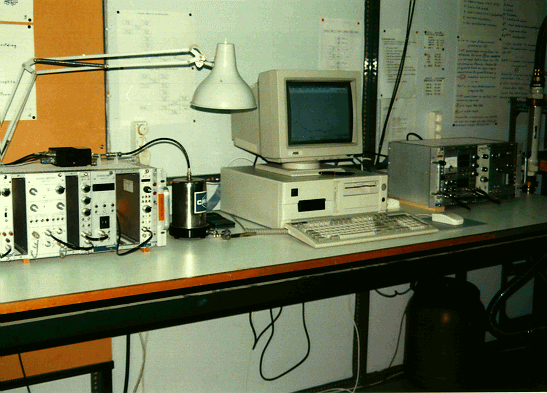NATIONAL TECHNICAL UNIVERSITY OF ATHENS
Nuclear Engineering Section
RADON EXHALATION MEASUREMENTS
Exhalation Container
The exhalation rate of building materials with relatively high
radium concentrations was assessed using a specially
designed steel clad 1m³
 air-tight container ([10, 1994],
[11,1994]);
the volume of the sample
material, which could also be a structural module such as a
test wall
or slab, should not exceed 10% of the total volume of the container.
The following important environmental parameters, which affect an
exhalation experiment, are monitored in the container through
analogue-to-digital converters interfaced to the bus of a
PC
: pressure
changes, using a ±50 mbar differential pressure transducer,
temperature and relative humidity. An aerosol generating system is
also used to produce particles.
air-tight container ([10, 1994],
[11,1994]);
the volume of the sample
material, which could also be a structural module such as a
test wall
or slab, should not exceed 10% of the total volume of the container.
The following important environmental parameters, which affect an
exhalation experiment, are monitored in the container through
analogue-to-digital converters interfaced to the bus of a
PC
: pressure
changes, using a ±50 mbar differential pressure transducer,
temperature and relative humidity. An aerosol generating system is
also used to produce particles.

Three methods are employed for determining the radon concentration
in the container environment. Two of these methods are based on grab
sampling of a small portion (15-20%) of the container gas through
filters. The filters are then analysed using:
-
alpha-spectroscopic analysis of the radon daughters Po-218
and Po-214 using a PIPS detector set-up.
-
gamma-spectroscopic analysis of the radon daughters Pb-214
and Bi-214 using a Ge detector set-up.
A third method, was applied in order to conduct in-situ radon
progeny measurements inside the container, using an Am-241
doped 2x2" NaI detector, which records the area under the 609 keV
photopeak of Bi-214.
For the calibration of the container a Pylon 2000A - NIST
cross-certified source of a nominal Ra-226 activity of 102.8 kBq was
used. According to the systematic results already obtained in a clean nitrogen
 environment, within the range of radon concentrations 0.1-30 kBqm¯³,
temperature 19-21 °C and relative humidity 30-40%, the collection efficiency,
when sampling 160 L of gas through 37 mm glass microfiber submicron filters
for 5 minutes, was determined as 10±1.5%. Furthermore, preliminary results show
that the collection efficiency is increasing with the aerosol concentration inside
the container, up to a maximum of 4 times.
environment, within the range of radon concentrations 0.1-30 kBqm¯³,
temperature 19-21 °C and relative humidity 30-40%, the collection efficiency,
when sampling 160 L of gas through 37 mm glass microfiber submicron filters
for 5 minutes, was determined as 10±1.5%. Furthermore, preliminary results show
that the collection efficiency is increasing with the aerosol concentration inside
the container, up to a maximum of 4 times.
Exhalation Rate Results
A least squares fitting to the radon growth curve of the examined
materials was used to calculate their radon exhalation rate; for this
purpose each one of the specimens was enclosed in the container for
a period of about 20 days. The estimated effective decay constants
did not significantly differ from the decay constant
of Rn-222; the total uncertainty associated with these calculations
was about 25%. According to the results obtained the cement specimens
with Ra-226 concentrations in the range 100-140 Bq/kg
([9, 1994],
[11, 1994])
present
exhalation rates between 15-20 µBqkg¯¹s¯¹. Brick specimens
pulverised to less than 90 µm with Ra-226 concentrations in the range 28-48 Bq/kg
present exhalation rates between 3-10 µBqkg¯¹s¯¹.
Furthermore, two typical greek structural modules, a clay brick wall and
a concrete slab, of an exhaling area of 1m², constructed from raw
materials with the highest Ra-226 concentrations detected, were also
tested. The exhalation rate of the wall, with calculated value of Ra-226
content equal to 40 Bq/kg, was 2mBqm¯²s¯¹ while that of the slab with
Ra-226 content equal to 26 Bq/kg, was 3 mBqm¯²s¯¹. Assuming a
typical Greek room (4x4x3.5m) constructed using materials with the
above exhalation rates, and an air-exchange rate of 0.5/h the
maximum radon concentration is assessed equal to 34 Bq/m³,
which is much lower than the 150 Bq/m³ recommended action
level.
Back to the Previous Page
 air-tight container ([10, 1994],
[11,1994]);
the volume of the sample
material, which could also be a structural module such as a
test wall
or slab, should not exceed 10% of the total volume of the container.
The following important environmental parameters, which affect an
exhalation experiment, are monitored in the container through
analogue-to-digital converters interfaced to the bus of a
PC
: pressure
changes, using a ±50 mbar differential pressure transducer,
temperature and relative humidity. An aerosol generating system is
also used to produce particles.
air-tight container ([10, 1994],
[11,1994]);
the volume of the sample
material, which could also be a structural module such as a
test wall
or slab, should not exceed 10% of the total volume of the container.
The following important environmental parameters, which affect an
exhalation experiment, are monitored in the container through
analogue-to-digital converters interfaced to the bus of a
PC
: pressure
changes, using a ±50 mbar differential pressure transducer,
temperature and relative humidity. An aerosol generating system is
also used to produce particles.

 environment, within the range of radon concentrations 0.1-30 kBqm¯³,
temperature 19-21 °C and relative humidity 30-40%, the collection efficiency,
when sampling 160 L of gas through 37 mm glass microfiber submicron filters
for 5 minutes, was determined as 10±1.5%. Furthermore, preliminary results show
that the collection efficiency is increasing with the aerosol concentration inside
the container, up to a maximum of 4 times.
environment, within the range of radon concentrations 0.1-30 kBqm¯³,
temperature 19-21 °C and relative humidity 30-40%, the collection efficiency,
when sampling 160 L of gas through 37 mm glass microfiber submicron filters
for 5 minutes, was determined as 10±1.5%. Furthermore, preliminary results show
that the collection efficiency is increasing with the aerosol concentration inside
the container, up to a maximum of 4 times.